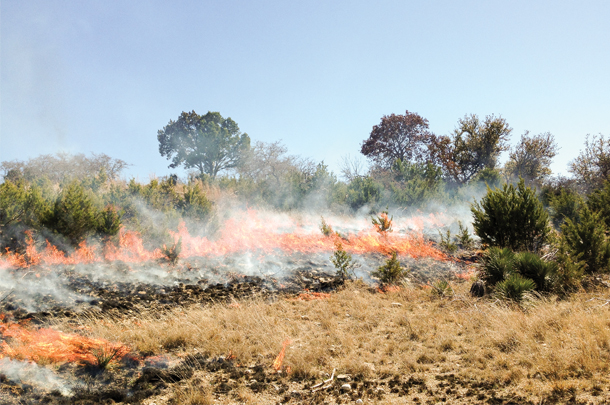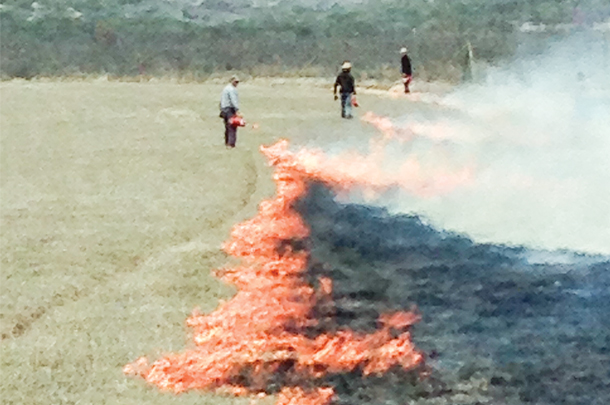Fire is a naturally occurring process that is not centered on if, but when, it will happen on rangeland. As rangeland managers, we have the choice as to the type of fire that occurs in our pastures.
Waiting for a wildfire is neither a good offense nor a good defense, similar to the old Marine philosophy, “Which mountain do you want to die on?” It boils simply down to proactive versus reactive attitudes and perspectives.
As the 2015-2016 El Niño season finishes up, a question on every rancher’s mind should be: Are we ready for the start of the next drought/wildfire season? Stocking densities haven’t recovered from the last drought, and fuel loads across Texas and parts of the Southwest are high due to the strong El Niño season. Producers should be feeling antsy about the (wildfire) fuel-loading problem that is in their pastures.
I don’t want to oversimplify the decision of planning prescribed fires, or being a victim to wildfire, but wildfires burn out at prescribed fires. Try the Bastrop Complex Fire in 2011 on for size, when wildfire severity and effects at Bastrop State Park were greatly minimized from a previously conducted prescribed burn in 2010.
The presence of fire on a landscape determines its future. Nature benefits from either type of fire, but we suffer as producers from the damage done by fires we do not plan for. The planning for either type of fire ultimately determines a producer’s future.
A historical perspective
Most producers are hesitant to adopt prescribed burning because of the misconception their grazing operation suffers. However, fire and grazing are natural and symbiotic processes in maintaining productive grassland and savannah plant communities.
Active fire suppression has been recognized as a key disruptive force in rangeland ecosystem integrity throughout North American rangelands and the world.
Before European settlement and their introduction of domestic livestock grazing practices, native plant communities were maintained by periodic fires and the grazing patterns of native wildlife. Early Native Americans observed that buffalo consumed mostly grass and preferred areas dominated by grass.
They also realized fire was needed to maintain open prairies. Fire was an important tool to manipulate the vegetation with the purpose of improving habitat. Numerous written accounts support the use of fire by Native American Indians.
“In the spring, the Indians throughout the buffalo country burned off the old grass in places where they had not used a fire drive in the previous autumn. Until the new grass attracted the buffalo herds …” Amos Parker also reported in 1834 that “prairies are all burnt over twice a year – in mid-summer and about the first of winter.”
Early European ranchers had very little experience in semi-arid grasslands and, consequently, did not anticipate the adverse effects of overgrazing and fire suppression on rangeland structure and function. These management changes slowly transitioned native plant communities from savanna grasslands to dense woodland communities.
Since then, rangeland managers have spent more than 60 years seeking methods to reduce woody plant species in an effort to reverse the downward trend in herbaceous plant productivity and species diversity. After almost a century of official and successful anti-fire campaigns, the benefits of conducting prescribed burns are gaining both scientific and cultural attention as a sound range management tool.
Sparking productivity
Fire’s ecological effects are numerous and complex. Fire can manipulate nutrient dynamics, soils, vegetation, grazing patterns and grazing behavior of animals. Primary factors affecting plant community response are timing, frequency and intensity of fire relative to the biology and origin of the flora and fauna examined.
Generally speaking, with average precipitation, native perennial grass productivity typically increases with average growing conditions following a low-intensity fire.
Neutral responses in total productivity occur when increases in native perennial grasses are offset by reductions in annual grasses and weedy forbs, which are predominantly non-native and non-preferred species.
Fire causes an immediate reduction of standing dead material and litter, which presents a loss in forage in the short term. However, with average annual precipitation, the reduction in litter can alter light and moisture relations at the soil surface, promoting increased herbaceous productivity and discouraging the establishment of non-native species.
Reduction of standing dead material and litter, as well as improved forage quality of new plant growth, attracts grazing animals to recently burned sites.
Response to fire can be species-specific, allowing targeted control of undesirable and woody species such as prickly pear cactus, eastern red cedar and blueberry juniper.
Prescribed fire has been shown to be the most efficient and economical method for controlling invasive, non-sprouting native juniper. Intense and frequent fire can result in a direct reduction in canopy cover of woody plants by killing, injuring or reducing trees to smaller-size classes.
Following fire, browsing animals may further inhibit recovery of woody plant species due to increased accessibility and palatability. As an evolutionary process, fire cannot be substituted with any other management option, and the combination of grazing and fire epitomizes the most natural symbiotic relationship on rangelands.
After the fire
Keep in mind that prescribed burning is not a one-time, cure-all, silver-bullet treatment but a routine program that must be maintained. Fire frequency is the key to success.
Native rangeland vegetation is adapted to periodic burning. However, fires can be destructive if proper management is not followed before and after the prescribed burn.
Livestock and wildlife are easily attracted to recently burned areas and can overgraze the burned area if given the opportunity. Rangeland recovery following a prescribed burn is a key element that goes hand-in-hand with a properly planned, timed and executed prescribed burn.

Prescribed fire in Texas and elsewhere faces an uncertain future. Historic use of prescribed fire by ranchers has never been widespread; however, with the rapid increase in population and increased “urbanization” of rangeland, air quality concerns, county officials quick to implement burn bans, new landowners who don’t understand the ranching culture and lack the experience and background to appreciate the value of fire, etc., the implementation of fire will be even more difficult in the future.
However, these potential problems should not lessen our enthusiasm for prescribed fire. In fact, now is the time to become bold and innovative in the use of prescribed fire – but to also be prudent.

Members of the Edwards Plateau Prescribed Burn Association in Texas have successfully burned approximately 1 million acres of rangeland. So join a prescribed burn association, participate on other burns and attend certified prescribed burn schools.
It is my hope that this article will spark a better understanding for the problems facing the continued use of prescribed fire, fan a greater appreciation for the future role fire should play in your region and re-ignite the fire culture that manipulated such a basic, natural tool to historically make our rangelands so profitable and sustainable. ![]()
PHOTO 1: Blackland prairie in east Texas burns during a summer prescribed fire conducted by Conservation Fire Team (Brian Treadwell) on the Bluestem Cattle Company Ranch near Fort Worth, Texas.
PHOTO 2: A successful summer prescribed burn by Conservation Fire Team (Brian Treadwell) in west-central Texas on a 1,000-acre burn unit dominated by juniper burns, ironically, during the same time the Fort McKavett Complex Wildfire burnt 15,000 acres just 10 miles northeast of the prescribed burn unit.
PHOTO 3: Conservation Fire Team (Brian Treadwell) implements a summer prescribed burn on a bermuda hay grass field near Sonora, Texas. Photos provided by of Morgan Russell.

-
Morgan Russell
- Range Specialist
- Texas A&M AgriLife Extension Service
- Email Morgan Russell







